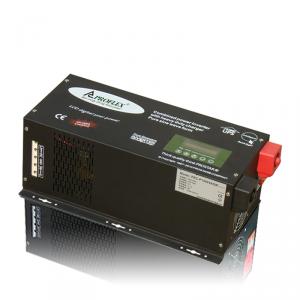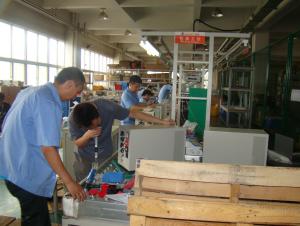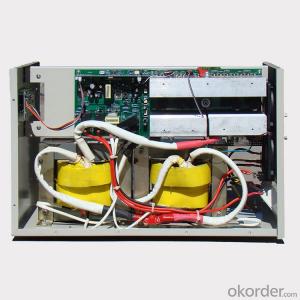Pure Sine Wave Power Inverter with Battery Charger 5kw
- Loading Port:
- Tianjin
- Payment Terms:
- TT OR LC
- Min Order Qty:
- 10 pc
- Supply Capability:
- 10000 pc/month
OKorder Service Pledge
OKorder Financial Service
You Might Also Like
Item specifice
Specifications
DC to AC power inverter
Pure sine wave
with battery charger
standard LCD display
Battery charge current can be manually set
DC TO AC INVERTER
PURE SINE WAVE WITH BATTERY CHARGER
Advantages
> Ultra-fast transfer timeFrom AC to DC less than 5ms,
> From DC to AC 0ms (Routers, Switches PC, Servers and ATM machine will never re-start at Mains failure)
> Faster battery recharge time (Big charge current 30A~50A)
> Automatic tracking mains or generator input (Tracking input voltage, phase & frequency)
> AC / DC conversion waveform (Seamless connection without any spike)
> Battery equalization system (for longer battery life)
> Protection against short-circuit, low voltage, overload, over temperature and over-charge
> Low maintenance cost, LED & LCD Dual display
Application range
Computer, Telecom, Deep Freezers, Air Conditioners, Petrol pump machines, Small Scale Industries Malls, Hotels,
Restaurants, Banks, ATM Machines, Clinics, All kinds of Kitchen appliances & Home appliances, Weighing bridges,
Elevators etc.
Technical Specification
| PRC-PSW SERIES | 500VA | 1000VA | 1500VA | 2000VA | 3000VA | 4000VA | 5000VA | 6250VA |
| POWER CAPACITY | 400W | 800W | 1200W | 1600W | 2400W | 3200W | 4000W | 5000W |
| BATTERY DC VOLTAGE | 12V/24V/48V | 24V/48V | ||||||
| INPUT AC RANGE | 140~280V / 45~55Hz | 165~275V / 45~55Hz | ||||||
| INVERTER OUTPUT | 220V ± 10% / 50Hz ± 1% | Without AVR function | ||||||
| TRANSFER (AC LOSS) | 5ms after AC loss, automatic recovery after utility power back | |||||||
| WAVE DISTORTION | THD < 3% | |||||||
| OVER LOAD CAPACITY | 100% ~ 125% Keep Beeping; > 125% working 30s; >150% 1s shut down | |||||||
| OUTPUT SOCKET | terminal connectors | |||||||
| INDICATOR STATUS | Utility input with "POWER" & "BYPASS" light on | |||||||
| Utility power loss with "INVERTER" light on | ||||||||
| Connected with load "AC OUTPUT" light on | ||||||||
| Warning for battery low & over load with " ! " flashing | ||||||||
| Battery low protection, over load protection, short circuit protection with " ! " light on | ||||||||
| BATTERY CAPACITY | From left to right 4 indicator means 100%, 75%, 50%, 25% (" ! "Flashing) | |||||||
| CHARGE STATUS | Indicator flash change from 50% →75% → 100% every 1second means "CONSTANT CURRENT" | |||||||
| Indicator flash change from 50% →75% → 100% every 2second means "CONSTANT VOLTAGE" | ||||||||
| Indicator 50%/75%/100% 3lights on means "FLOAT CHARGE" & battery full | ||||||||
| CHARGE CURRENT | Maximum 12V 30A / 24V 20A / 48V 10A | Maximum 24V 50A or 48V 30A | ||||||
| 10A → 20A → 30A Adjustable | 10A → 30A → 50A Adjustable | |||||||
| RECHARGE TIME | 8~10hours | |||||||
| POWER EFFICIENCY | 88% at full load | 85% at full load | ||||||
| NOISE CONDITION | < 45dB | |||||||
| TEMPERATURE | —10°C ~ 40°C (Operation environment); —20°C ~ 50°C (Stock environment) | |||||||
| HUMIDITY | 0~95% no condensation | |||||||
| SIZE OF INVERTER | 550 x 250 x 200mm | 650 x 250 x 200 mm | 68x31x28cm | |||||
| SIZE OF PACKAGE | 58x28x23cm / 1unit | 68x28x23cm / 1unit | 71x34x31cm | |||||
| TYPE OF PACKAGE | Honeycomb carton | |||||||
| WEIGHT OF INVERTER | 11kg | 13kg | 14kg | 25kg | 27kg | 38kg | 39kg | 47kg |
| WEIGHT AFTER PACKAGING | 13kg | 15kg | 16kg | 27kg | 29kg | 40kg | 41kg | 49kg |
Advantages
CPU control, Low frequency
Pure sine wave output
5ms transfer time for AC to DC
Input voltage range 80V~140V/160V~265V
Input frequency range 45~55Hz/55~65Hz
Easy to install, easy to use
Intelligent automatic charging
Compatible with generators
Using line interactive circuit technology
Automatically AC bypass
Software & SNMP card optional with adding cost
Electronic Protections
Overload, short circuit protection
Over temperature protection
Over voltage, low voltage protection
Low battery protection


- Q:Can solar energy systems be used for powering signs or billboards?
- Yes, solar energy systems can be used to power signs or billboards. Solar panels can be installed on or near the signs to capture sunlight and convert it into electricity, which can then be used to power the signs. This is a sustainable and environmentally friendly solution as it reduces reliance on traditional energy sources and reduces carbon emissions. Additionally, solar-powered signs can be installed in remote locations where accessing grid electricity may be difficult or expensive.
- Q:How does the efficiency of solar panels vary across different installation locations?
- The efficiency of solar panels varies across different installation locations due to various factors such as the amount of sunlight received, the angle and orientation of the panels, shading, temperature, and local weather conditions.
- Q:Can a solar energy system be installed in a remote location without access to the electrical grid?
- Indeed, it is possible to install a solar energy system in a distant area that lacks access to the electrical grid. Solar power systems employ photovoltaic (PV) panels to transform sunlight into electricity. Even if these panels are situated far away from the electrical grid, they can still be established in locales with ample sunlight. In such instances, an off-grid solar energy system can be utilized. This system consists of solar panels, a battery bank, and an inverter. The solar panels amass sunlight and convert it into electrical energy. This energy is then stored in the battery bank for usage during nighttime or cloudy days when sunlight is not readily accessible. The inverter is employed to convert the stored DC (direct current) power from the batteries into AC (alternating current) power, which is the standard form of electricity used in homes and buildings. Off-grid solar systems are frequently employed in remote areas like cabins, campsites, and rural regions where connecting to the grid is not practical or cost-effective. These systems offer a dependable and sustainable source of energy, reducing reliance on traditional generators powered by fossil fuels or other energy sources. Furthermore, solar energy is a clean and renewable source, rendering it an environmentally conscious choice. Although installing a solar energy system in a remote location without access to the electrical grid may present more challenges and expenses compared to grid-connected systems, the long-term advantages and energy independence make it a feasible solution.
- Q:Can solar energy be used for large-scale power generation?
- Yes, solar energy can be used for large-scale power generation. With advancements in technology and decreasing costs of solar panels, solar power plants are being built around the world to generate electricity on a massive scale. These power plants can be grid-connected and provide clean and renewable energy to meet the increasing demand for electricity.
- Q:What is solar energy?
- Solar energy is a renewable form of energy that is derived from the sun's radiation. It is harnessed using solar panels or photovoltaic cells, which convert sunlight into electricity or heat. Solar energy is clean, abundant, and sustainable, making it an environmentally friendly alternative to fossil fuels.
- Q:How do solar energy systems impact energy conservation efforts?
- Solar energy systems have a significant impact on energy conservation efforts by providing a sustainable and renewable source of power. By harnessing the sun's energy, these systems reduce the reliance on fossil fuels, which helps to mitigate greenhouse gas emissions and combat climate change. Additionally, solar energy systems promote energy independence and decentralization, allowing individuals and communities to generate their own electricity and reduce their dependence on traditional energy grids. Overall, solar energy systems play a crucial role in conserving energy and promoting a greener future.
- Q:Can solar energy systems be used for powering electric vehicle research and development centers?
- Electric vehicle research and development centers can utilize solar energy systems for power. Solar energy, being a renewable and clean source, contributes to reducing the carbon footprint of these centers. The installation of solar panels on the rooftops or in open spaces allows the centers to harness solar energy and convert it into electricity for various operations. This approach not only provides sustainable energy but also lessens reliance on conventional electricity and fossil fuels. Moreover, the use of solar energy leads to long-term cost savings, as the initial investment in solar panels can be offset by reduced electricity bills. In conclusion, solar energy systems are a feasible and environmentally friendly choice for powering electric vehicle research and development centers.
- Q:What is the impact of shading on the performance of solar panels?
- The performance of solar panels is greatly affected by shading, as it reduces the amount of sunlight reaching the cells and decreases energy production. This is because solar panels convert sunlight into electricity through the photovoltaic effect. When a solar panel is partially shaded, it creates a phenomenon called the "hotspot effect." This occurs when shaded cells within the panel become a pathway with high resistance for electricity flow, resulting in localized temperature increase. The increased heat can compromise the panel's performance and reduce its efficiency. Furthermore, shading also impacts the panel's voltage and current output. Solar panels are typically connected in series to increase voltage output. However, even a single shaded panel can significantly hamper the performance of the entire series-connected string. The shaded panel acts as a bottleneck, restricting current flow throughout the string. To minimize the effects of shading, various solutions can be employed. One commonly used method is the incorporation of bypass diodes, which allow current to circumvent the shaded cells and prevent the hotspot effect. By utilizing bypass diodes, energy loss due to shading can be minimized, ensuring that the rest of the solar panel operates efficiently. Additionally, proper design and placement of solar panels can help mitigate shading effects. Installing panels in areas with minimal obstructions or shadows, such as rooftops or open fields, maximizes their exposure to sunlight. Regular maintenance, including trimming nearby trees or vegetation that may cast shadows, is also crucial for optimal performance. In conclusion, shading significantly impacts the performance of solar panels, resulting in reduced energy production and efficiency. Understanding and addressing shading issues through the use of bypass diodes and careful installation can maximize the effectiveness and output of solar panel systems.
- Q:How does a solar panel convert sunlight into electricity?
- A solar panel converts sunlight into electricity through the photovoltaic effect. The panel contains silicon-based solar cells that absorb photons from sunlight. These photons transfer their energy to electrons in the silicon atoms, causing them to become excited and break free. The electric field within the solar cell then directs these electrons to flow in a specific direction, creating a current. This current is then harnessed and used as electricity.
- Q:Can solar energy systems be used in powering scientific research vessels or marine laboratories?
- Yes, solar energy systems can definitely be used to power scientific research vessels or marine laboratories. Solar energy is a renewable and sustainable source of power that can be harnessed using photovoltaic panels or solar thermal collectors. Research vessels and marine laboratories require a significant amount of energy to carry out their operations, which often includes scientific experiments, data collection, and analysis. These activities typically involve equipment such as computers, sensors, and lab instruments that require a constant and reliable source of power. Solar energy systems can be installed on these vessels or laboratories to provide a clean and efficient source of electricity. The photovoltaic panels convert sunlight into electricity, which can then be used to power the various equipment and systems onboard. Additionally, excess energy produced by the solar panels can be stored in batteries for use during periods of low sunlight or at night. Utilizing solar energy in these marine environments offers several advantages. First, it reduces the dependence on fossil fuels and minimizes the carbon footprint associated with traditional power generation methods. This is especially important in the context of scientific research, as it aligns with the principles of environmental sustainability and conservation. Second, solar energy systems provide a reliable and independent source of power. Research vessels and marine laboratories often operate in remote or isolated locations where access to traditional power grids may be limited or non-existent. By utilizing solar energy, these vessels and facilities can generate their own electricity and continue their research activities without relying on external power sources. Finally, solar energy systems are low-maintenance and have a long lifespan. Once installed, they require minimal upkeep and can withstand the harsh marine environment. This makes them well-suited for use in research vessels or marine laboratories, where downtime and maintenance issues can be disruptive to ongoing scientific projects. In conclusion, solar energy systems can certainly be used to power scientific research vessels or marine laboratories. They offer a sustainable, reliable, and independent source of electricity, reducing the carbon footprint and ensuring uninterrupted research activities even in remote locations.
1. Manufacturer Overview |
|
|---|---|
| Location | |
| Year Established | |
| Annual Output Value | |
| Main Markets | |
| Company Certifications | |
2. Manufacturer Certificates |
|
|---|---|
| a) Certification Name | |
| Range | |
| Reference | |
| Validity Period | |
3. Manufacturer Capability |
|
|---|---|
| a)Trade Capacity | |
| Nearest Port | |
| Export Percentage | |
| No.of Employees in Trade Department | |
| Language Spoken: | |
| b)Factory Information | |
| Factory Size: | |
| No. of Production Lines | |
| Contract Manufacturing | |
| Product Price Range | |
Send your message to us
Pure Sine Wave Power Inverter with Battery Charger 5kw
- Loading Port:
- Tianjin
- Payment Terms:
- TT OR LC
- Min Order Qty:
- 10 pc
- Supply Capability:
- 10000 pc/month
OKorder Service Pledge
OKorder Financial Service
Similar products
New products
Hot products
Hot Searches
Related keywords






























